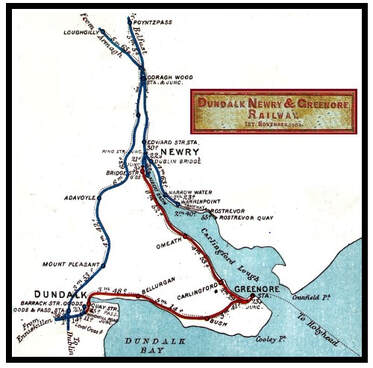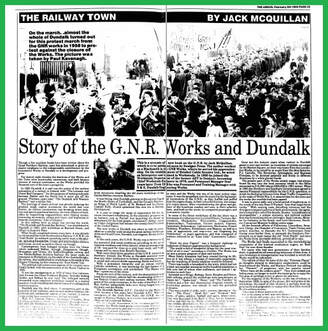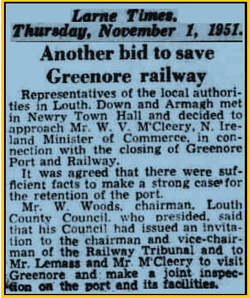|
Prince Charles explains 'pebble theatre'.
|
PEBBLE
|
|
Don Pierson [right] explains how a young Prince Charles made a request to join the Radio London fan club. |
|
|
Prince Charles explains 'pebble theatre'.
|
PEBBLE
|
|
Don Pierson [right] explains how a young Prince Charles made a request to join the Radio London fan club. |
|
 The story of the rail lines and the related ferry service that once connected Greenore to the rest of Ireland and then the outside world, is far from straightforward. Because our own interest in these rail lines in peripheral to the overall subject matter of this Blog, we have turned to others who specialize in such information for our own enlightenment. One such site is John Speller's Web Pages about the Irish Railways. See: https://spellerweb.net/rhindex/Ireland/Dundalk.html The story of behind the rail and ferry services centered on Greenore, began in 1867 with the London and North Western Railway (LNWR) which operated a rail-head at Holyhead in Anglesea, with rail links across the island of Great Britain, selecting the fishing port of Greenore to build a new harbor; a pier; a modern hotel, and a railway station terminal and railway line that connected to the town of Newry to the north of Greenore. Adjacent to the rail-head the company also built a modern hotel, and in the surrounding area, it encouraged the start of a small town with street names such as Anglesea Terrace and Euston Street; together with another area devoted to extensive cattle pens. Three years later in 1873 a ten mile stretch of track was opened to link Greenore with Dundalk to its south-west. When the majority of the island of Ireland gained independence in 1922, the LNWR was swallowed up by a new London, Midland and Scottish Railway (LMS) company. In 1927, with the ports of Belfast and Dublin having direct access to large population centers, the passenger ferry service to Greenore, was withdrawn. In 1933, LMS signed an agreement with the Great Northern Railway (Ireland) company, (GNRI) to manage its affairs in the Republic of Ireland. GNRI became an international oddity, because this one railway company had a cross-border service linking both the Republic of Ireland with its Irish rump designated as Northern Ireland. While the majority of the island was controlled by a legislature in Dublin, the rest of the island was still under the control of the British Crown corporation sole based in London, England. Then came World War II and the Republic of Ireland decided to remain neutral. The Greenore passenger ferry service had already stopped back in 1927, and now all freight shipments by sea from Greenore were reduced in 1940 to once a week. Because all of the GNRI locomotives were still being serviced in Dundalk at its Locomotive Works, that facility was governed by a cross-border consortium of business interests.  "For almost eight decades the destinies of the Works and the Town were inextricably interwoven, and both became sources of sources of mutual sustenance, as the Works provided the core for the town's prosperity." "It was the amalgamation in 1876 of .... four railways, that formed the Great Northern Railway formally linking Dublin and Belfast by iron road. The enlarged network demanded more extensive workshops located in a central position for the building and maintenance of its rolling stock and locomotives." The quotations above have come from a feature on pages 24-25 of The Argus, and dated February 5, 1993. The original source material is based upon a book about GNR by Jack McQuillan. Due to increased competition from road and air transport between the two Irish nations, in 1947, GNR introduced a non-stop service between Dublin and Belfast, but it was not profitable. The following year on January 1, 1948, the Great Western Railway (GWR); London, Midland & Scottish Railway (LMS); London & North Eastern Railway (LNER), and Southern Railway (SR), were all swallowed up in a post-WWII act of socialized nationalization of rail and road transportation governed by the British Crown via its Parliament in London, and consequently the formation of British Railways absorbed the LMS-GNRI contract. In 1951, the Northern Ireland interests of British Railways in the Dundalk Locomotive Works were terminated almost over night, and almost immediately 1,200 employees at the Dundee Locomotive Works were given one week's notice before their jobs vanished.  Meanwhile, in 1951 over in Greenore, the trains stopped running and its once-a-week cargo shipments were also brought to an end. Remember, the passenger ferry service ended in 1940, and so the entire property of the railway company at Greenore was allowed to fall into a state of disrepair. Sitting on a peninsula, Greenore was not a part of any major population center, and therefore it did not retain any commercial value for business interests. Back in Dundalk a political storm erupted, and both Irish governments agreed to subsidize the Dundalk Locomotive Works which at that time was still a private company. But by the end of 1952, with the company drowning in debt, the two governments agreed to create the Great Northern Railway Board (GNRB) and take over the remaining assets and debts of the former private company. "It was to prove sadly only a brief period of euphoria .... 'Into that magic burst reality' .... With the soaring costs, dwindling revenues and the divergent transport policies of both governments, the agreement toward the end of the decade became a 'misalliance of incompatibles'. a unique economic and political cocktail that was fermenting into an imbroglio ...." which is defined as an "extremely confused, complicated, or embarrassing situation". So in 1958 the GNRB was also killed-off and its assets were then divided between Northern Ireland's Ulster Transport Authority and Eire's Córas Iompar Éireann. Although these two bodies had already terminated most of the rail services of the former GNRI network; they did not close the Dublin to Belfast line.
That is when the Irish government helped to establish Dundalk Engineering Works and other companies which included Heinkel Cabin Scooters Ltd.
But even this remedy was not to last. To find out what happened next, please check in tomorrow! Comments are closed.
|
Our team produced this free radio program for PCRL in Birmingham.
It was repeatedly broadcast on and after October 20, 1985. Click & listen! Blog Archive
August 2023
Copyright 2021 with all rights reserved.
|
Index |
Library |
|
